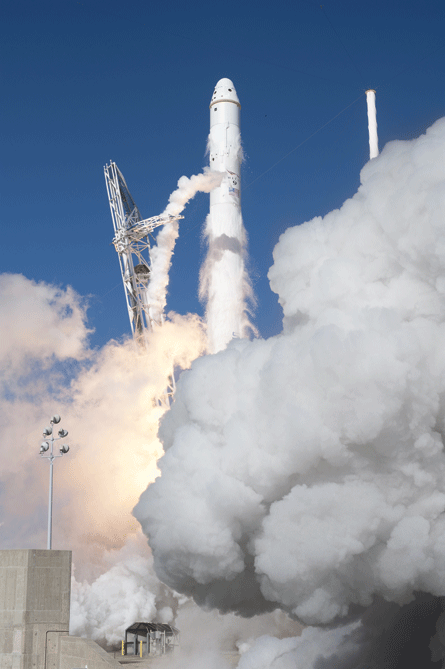SpaceX's Dragon capsule became the first successful commercial space vehicle when it lifted off aboard the California-based company's Falcon 9 on a mission co-sponsored by NASA and was recovered from its Pacific Ocean splashdown hours later.
The "extremely successful" 8 December mission marked NASA's first launch of a commercial vehicle and the start of its demonstration programme to develop new ones, as well as the Federal Aviation Administration's first issue of a licence to a commercial company to re-enter a spacecraft from orbit.
The launch, the second for the Falcon 9 two-stage-to-orbit rocket, was intended to prove the structural integrity of the Dragon spacecraft and its on-orbit operation, re-entry, descent and splashdown in the Pacific Ocean. By all accounts the flight was a great success, particularly for a first outing.
 |
|---|
© SpaceXDragon capsule becomes first successful commercial space vehicle on mission co-sponsored by NASA |
"My mind is blown. There's so much that can go wrong and it all went right," says SpaceX chief executive Elon Musk, the Silicon Valley internet entrepreneur who made a fortune founding the PayPal payment system before starting SpaceX and the Tesla all-electric sports car company. "I'm sort of in semi-shock. I wish I could be more articulate at moments like this. But it's hard to be articulate with a blown mind."
LIFT OFF
The Falcon 9's nine liquid oxygen and RP-1 kerosene-fuelled Merlin engines lifted off with the 48m (158ft) rocket from Cape Canaveral in Florida at 10:43 EST. Nine minutes and 11,000ft later, the second stage, also a Merlin engine, shut down and separated from the Dragon capsule, heading for a 300km (186 mile) circular orbit at a 34.5e_SDgr inclination. After two trips around the Earth - which took about 2.5h - Dragon descended toward the Pacific Ocean at a rate of about 8m per second, hitting its target splashdown location within 800m and one minute of its target time, "which was awesome", says SpaceX president Gwynne Shotwell.
The Dragon capsule contained only an as-yet unidentified payload. The new heat shield co-developed by NASA Ames Research Center and SpaceX "barely noticed re-entry", the company says, and a steady temperature will easily be maintained in the cabin for cargo - even if the cargo is humans, which Musk says is an easy move to make.
"People sometimes think the difference between a cargo aircraft and putting crew in it requires this enormous amount of magical pixie dust, but that's just not the case," Musk says. "If there had been people in the cargo bay, they would have had a very nice ride." But before astronauts can ride the Dragon to the space station, an escape system and other safety measures need to be added - and more testing and data analysis needs to be completed.
The mission's only real glitch so far was the fact that it was postponed by a day after cracks were discovered in the nozzle extension of the Falcon 9's second-stage engine. SpaceX traced the problem to a GN2 vent line that "caused flutter of the thinnest portion of the nozzle extension, creating the cracks", the company says. Engineers hand-cut the bottom 1.2m off the nozzle extension and diffused the vent. Musk says he believes the rocket could have flown safely without the modification but made the change anyway in the name of caution.
Two more tests are scheduled for 2011, and Musk says SpaceX will be ready for the next mission by mid-year, expanding the flight envelope and possibly even going directly to the space station on the next mission - contingent on NASA's go-ahead, Musk says.
industry growth
NASA's Commercial Orbital Transportation Services (COTS) programme is aimed at spurring growth in the commercial space industry and facilitating the birth of a private space cargo industry. After the Space Shuttle fleet's planned retirement in 2011, NASA will otherwise be entirely reliant on the commercial side and the Russian Soyuz programme to deliver supplies and new crews to the ISS.
SpaceX holds a $1.6 billion contract with NASA for 12 cargo delivery missions to the ISS - rival Orbital Sciences landed a $1.9 billion deal for eight missions and is currently planning a 2011 test flight of its Taurus II rocket and Cygnus spacecraft.
The success of the COTS programme and the spacecraft born out of it would signal a new era in spaceflight - a move toward public-private partnership that could literally and figuratively launch a viable commercial industry.
"This is the first in a new generation of commercial launch systems that will help provide vital support to the International Space Station and may one day carry astronauts into orbit," says NASA administrator Charles Bolden. "This successful demonstration flight is an important milestone in meeting the objectives outlined by President Obama and Congress, and shows how government and industry can leverage expertise and resources to foster a new and vibrant space economy."
Source: Flight International


























